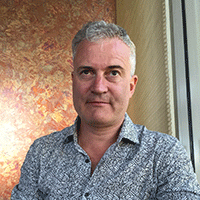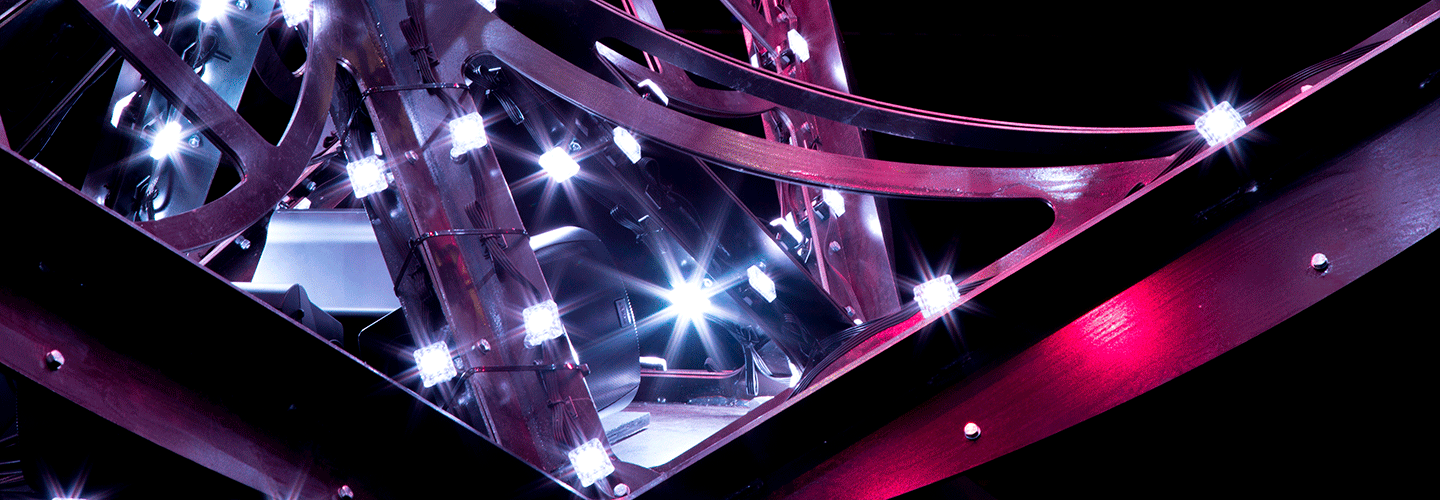Exploring science through art
Understanding our world using music and sculpture.
Cosmoscope, a monumental sound and light sculpture created by artist Professor Simeon Nelson and composer Rob Godman at the University’s School of Creative Arts, crosses the boundaries between science and art to explore the complexities of the universe.
Researched and built in collaboration with a team of leading physicists, cosmologists, engineers, a psychologist and a software architect, this spectacular multimedia installation depicts the universe, from the atomic scale to the cosmic, via human-scale biology. Incorporating data from all these scientific areas, its movements of light and music explore their patterns, structures and similarities.
The vast sculpture also looks at our changing conception of the cosmos through time. Inspired by historical astronomical instruments and models of the cosmos, the sculpture invites spectators to contemplate their place in the universe. From earth science to astrophysics, from the very small to the human to the very large, Cosmoscope draws on leading-edge science to offer a narrative of the origin, evolution and nature of life.
The team of artists and scientists, which included academics from Durham University's Institute for Computational Cosmology, developed digital systems that allowed sound and light systems to be fully integrated into the sculpture. Its programmable lighting, using more than 12,000 LED lights, was based on the physics of the very small, the human and the very large-scale structure of the cosmos. Equally, composer Rob Godman’s soundscape, mimicking the cycle of an astronomical clock, reflected the geometry of the sculpture and attempted to place the listener in both infinitely large and small spaces.
"Cosmoscope explored the cosmos at a range of length scales, incorporating input from scientists working at the smallest and largest scales."
Community involvement
Cosmoscope can be experienced by all – as an audio-visual spectacle, or as an object engaging with our own sense of place within the universe.
Simeon Nelson,
Lead artist
Reaching the widest possible audience was an important aim of the two-year project. Exhibited at the London Lumiere festival, Cosmoscope has been seen by an audience of over two million, including some 200,000 people through its premiere at the Durham Lumiere. The project also involved 700 primary school pupils from 25 schools across the Durham county, who took part in workshops designed to get them thinking about science, and its connection with art.
This community involvement and interdisciplinary approach was central to another of Simeon Nelson’s artworks, the Hydrosiren, a sculptural ‘singing boat’ created with Rob Godman and a team including students from the University’s School of Creative Arts.
“It was a wonderful event. It worked on many levels and I heard several new intriguing interpretations of the piece amongst the audience.”
The floating 10metre sculpture played a soundscape inspired by a stretch of canal and urban community gardens at Kensal Rise in London. The music sampled the sounds of the local community, blending human and animal life with unseen aquatic and insect life, as well as a soprano score sung live during a season of performances on the canal.
To create his soundscape, composer Rob Godman used ‘sound mirrors’ - parabolic microphones and speakers - as well as underwater and micro-recording techniques. Installed on the Hydrosiren, the sound mirrors added to the soundscape as they collected and emitted new sounds during its journey.
As with Cosmoscope, Hydrosiren invited spectators to explore our perception of time – from the very slow to the very fast – and our perception of scale, from the imperceptibly small, to human and urban. Both projects aimed to engage directly with the public, sharing with them the excitement of art, inspired by science.

Simeon Nelson
Lead artist
Simeon Nelson is a sculptor, new media and interdisciplinary artist interested in convergences between science, religion and art, complexity theory and relationships between art, architecture urban sites and the natural world.
He has received arts council grants in Australia and the UK, Pollock-Krasner Foundation Fellowships, Wellcome Trust and Leverhulme Trust funding. In 1997 he was the Australian representative to the IX Triennial India, New Delhi.
